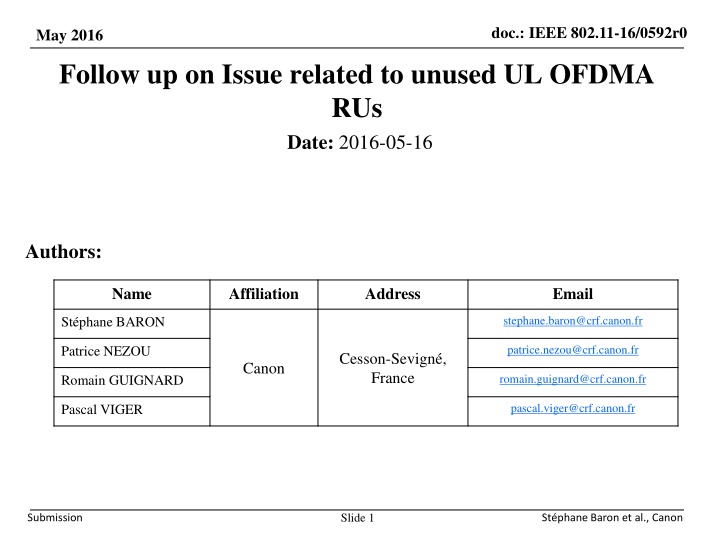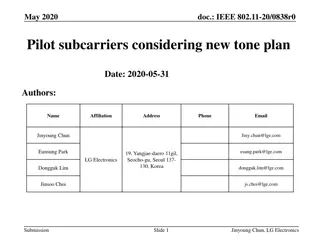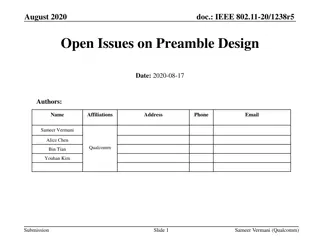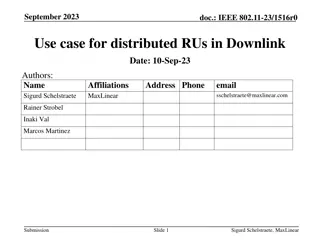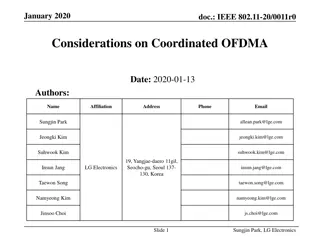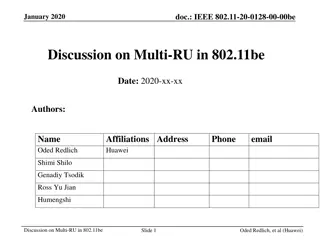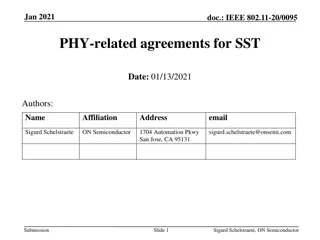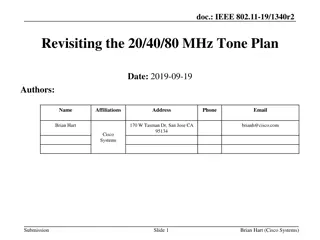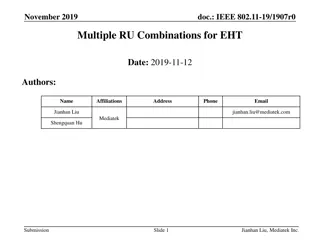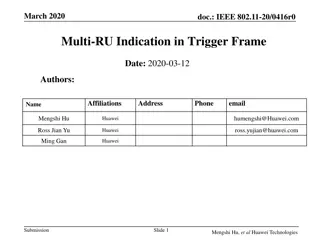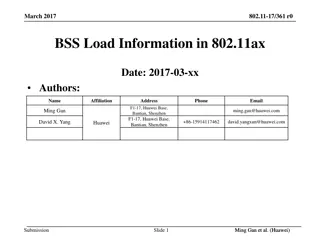IEEE 802.11-16/0592r0: Follow-up on Unused UL OFDMA RUs
In May 2016, a presentation by Stéphane Baron and team from Canon addressed the issue of unused Random Units (RUs) in UL OFDMA transmission in IEEE 802.11 standards. The presentation covers the consequences, simulation results showing significant unused RUs, and a proposed solution of random RUs interleaving to reduce impact. Detailed analysis and recommendations are provided regarding the management of random and scheduled RUs to enhance efficiency and avoid misleading scenarios.
Uploaded on Nov 19, 2024 | 2 Views
Download Presentation

Please find below an Image/Link to download the presentation.
The content on the website is provided AS IS for your information and personal use only. It may not be sold, licensed, or shared on other websites without obtaining consent from the author.If you encounter any issues during the download, it is possible that the publisher has removed the file from their server.
You are allowed to download the files provided on this website for personal or commercial use, subject to the condition that they are used lawfully. All files are the property of their respective owners.
The content on the website is provided AS IS for your information and personal use only. It may not be sold, licensed, or shared on other websites without obtaining consent from the author.
E N D
Presentation Transcript
doc.: IEEE 802.11-16/0592r0 May 2016 Follow up on Issue related to unused UL OFDMA RUs Date: 2016-05-16 Authors: Name Affiliation Address Email stephane.baron@crf.canon.fr St phane BARON patrice.nezou@crf.canon.fr Patrice NEZOU Cesson-Sevign , France Canon romain.guignard@crf.canon.fr Romain GUIGNARD pascal.viger@crf.canon.fr Pascal VIGER Slide 1 Submission St phane Baron et al., Canon
doc.: IEEE 802.11-16/0592r0 May 2016 Introduction In March 2016, we raised the issue of the consequences of having unused Rus in a UL MU OFDMA transmission [2]. The TGax SFD [1] includes specifications for the random access Trigger Frame (TF-R) A STA randomly selects any one of the assigned RUs for random access and transmits its UL PPDU in the selected RU Through simulation, ratio of unused RUs can be high (slide 3) This presentation proposes a solution to limit the impact of the unused random RUs. Submission Slide 2 St phane Baron et al., Canon
doc.: IEEE 802.11-16/0592r0 May 2016 Number of unused RUs in MU_UL OFDMA is also significant (especially in random access) Example of simulation results for random RU allocation (TF-R): Efficiency > 33% 35%<Unused RU<57% Efficiency > 33% 20% < Unused RU < 57% Note: some scheduled RUs may also be empty (because scheduled station still in doze state, or no data ready for tx) Slide 3 Submission St phane Baron et al., Canon
doc.: IEEE 802.11-16/0592r0 May 2016 Issue : unused RUs modify busy detection ? OFDMA UL (random allocation) Non-ht duplicate Used RU Primary channel ACK TF-R Unused RU ACK TF-R Secondary channel Collided RU Tertiary channel ACK TF-R Quaternary channel ACK TF-R SIFS SIFS A STA performs the energy-detect (ED) per single 20 MHz channel. Unused RUs can mislead (legacy or foreign OBSS) STAs, so they start transmitting. STA thinks the 20MHz sub-channel is free (false ED) Slide 4 Submission St phane Baron et al., Canon
doc.: IEEE 802.11-16/0592r0 May 2016 Proposed solution : random RUs interleaving. OFDMA UL (random RUs allocation) Non-ht duplicate Scheduled RUs Primary channel ACK TF-R Used Random RUs ACK TF-R Secondary channel Collided Random RUs Tertiary channel ACK TF-R Quaternary channel Unused Random RUs ACK TF-R SIFS SIFS The AP uniformly distributes the random RUs among the 20Mhz channel, to reduce the impact of having several unused RUs per 20Hz channel. The AP can group scheduled RUs but should avoid grouping random RUs in a single 20MHz channel. Slide 5 Submission St phane Baron et al., Canon
doc.: IEEE 802.11-16/0592r0 May 2016 Conclusion We note that the MU uplink transmission may lead to have unused RUs, and thus low-energy on corresponding 20MHz channel. We suppose that this could impact the tentatively reserved MU TXOP, by letting other (legacy/OBSS) transmission occur (same issue as the case of early termination of RU). As the efficiency of OFDMA random access is already low (<37%), it shall not be more damaged due to amount of unused RUs. We propose a solution to reduce the risk of collision by legacy devices due to the unused RUs by interleaving (uniformly distributing) the Random and Scheduled RUs in a Trigger Frame. Submission Slide 6 St phane Baron et al., Canon
doc.: IEEE 802.11-16/0592r0 May 2016 Straw Poll 1 Do You agree to add to the 802.11 draft specification the following text : 25.5.1.1 : When an AP allocates random RUs in a trigger frame, the AP should interleave random RUs with scheduled RUs over the overall reserved channel, to avoid having only Random RUs in a 20MHz channel. Y/N/A Submission Slide 7 St phane Baron et al., Canon
doc.: IEEE 802.11-16/0592r0 May 2016 References [1] 11-15/0132r15 Tgax Specification Framework , [2] 11-16/0333r0 Issue related to unused UL OFDMA RUs Submission Slide 8 St phane Baron et al., Canon
